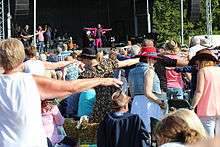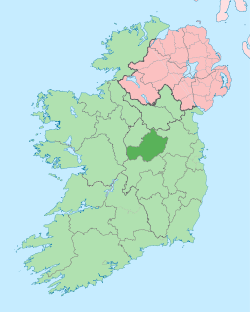Ballymore, County Westmeath
| Ballymore An Baile Mór | |
|---|---|
| Town | |
 Ballymore Location in Ireland | |
| Coordinates: 53°29′28″N 7°40′48″W / 53.491°N 7.68°WCoordinates: 53°29′28″N 7°40′48″W / 53.491°N 7.68°W | |
| Country | Ireland |
| Province | Leinster |
| County | County Westmeath |
| Elevation | 128 m (420 ft) |
| Population (2006) | |
| • Urban | 485 |
| • Rural | 2,165 |
| Time zone | WET (UTC+0) |
| • Summer (DST) | IST (WEST) (UTC-1) |
| Irish Grid Reference | N209490 |
Ballymore (Irish: An Baile Mór, meaning "big town") is a village in County Westmeath, Ireland, on the R390 road between Athlone and Mullingar. The historic Hill of Uisneach is nearby. The village was known in medieval times as the medieval borough of Ballymore Lough Sewdy, or Loughsewdy, after the nearby lake, the site of an ancient bruighean or hostel.
History
Evidence of the area’s bloody history can be deduced by translation of some of its placenames - although it’s not clear when some of these names came into being. One notable townland is Lugnacaha (often pronounced locally as “Lugahaca”), which translates as “the hollow of the battle”. There’s a field in Shinglis referred to as “Lug na Fola”, which translates as “the hollow of the blood”, and locally, it is claimed that when, once, an attempt was made to plough that field, blood seeped up through the soil.
Plary Abbey was founded before the year 700, and a monastery, in honour of the Virgin Mary, for Gilbertin canons, which order consisted of canons of the Premonstre order, and Benedictine nuns, was erected here by the de Lacey family. The church of this monastery was for a short time the cathedral church of the diocese of Meath.[1]
Brewer [2] states that the Gilbertine Abbey was founded in 1218, on the site of a monastery that had stood there from before the year 700. He describes the location as being "at the foot of the Hill of Clare, or Mullaghcloe", and says that on the summit are the ruins of Clare Castle.
In the year 1338, Theobald de Verdun, 2nd Lord Verdun, Justiciar of Ireland (born 8 September 1278), lord of the manor of Ballymore, obtained a grant of a weekly market, and a 15-day fair for in Ballymore.
As far back as 1315, Edward the Bruce, younger brother of Robert the Bruce of Scotland, came to the village. He arrived in Ireland in May 1315, and was proclaimed king within a month. He stormed through the country attempting to subdue it, and spent Christmas of 1315 in Ballymore, at the manor of Theobald de Verdun, reportedly using up all the stocks of food there and extending his thanks by burning the manor to the ground as he left.
Towards the latter end of the wars of 1641, Ballymore was home to a strong garrison of the English forces. Their garrison was located beside Lough Seudy, and divided from the mainland by "a deep and large graff, with ramparts of earth and bulwarks: the ditch was carried so low as to receive three or four feet of the stagnant water of the lake, over which was by a draw-bridge the entry into the fort; this was the chief fortress of this county". [3]
In 1831, Ballymore village consisted of 121 houses, chiefly small houses or cabins, forming one long street. Today it is still jokingly referred to as "the village with two ends and no middle".
Substantial emigration took place from Ballymore to Argentina in the 1800s.[4]
The Siege of Ballymore
The Williamite War in Ireland (Irish: Cogadh an Dá Rí, meaning "war of the two kings") was a conflict between Jacobites (supporters of Catholic King James II) and Williamites (supporters of Protestant Prince William of Orange) over who would be King of England, Scotland and Ireland. It is also called the Jacobite War in Ireland or the Williamite–Jacobite War in Ireland.
While James II was unpopular in England, he had widespread popular support in Ireland, and following the Glorious Revolution, in which he was overthrown by William of Orange who became William III of England, William landed a multi-national force in Ireland, composed of English, Scottish, Dutch, Danish and other troops, to put down Jacobite resistance. James left Ireland after a reverse at the Battle of the Boyne in 1690 and the Irish Jacobites were finally defeated after the Battle of Aughrim in 1691.
The Dutch-born Godert de Ginkell, 1st Earl of Athlone, Viscount of Aughrim and Baron of Ballymore, in the spring of 1691, on William's instructions, took command as Lieutenant General of the Williamite forces in Ireland.[5]
In the lead up to what was to become the Battle of Aughrim, Mullingar was fortified by General de Ginkell and it became the principal rendezvous of the Williamite forces.
With a large force of mounted and infantry troops, de Ginkell left Mullingar for Ballymore, where, in a fort on the shores of Lough Seudy, a thousand adherents of James II were encamped. There was a smaller force, consisting of a sergeant only and a few men in a castle "on an eminence at some distance from the village", and it was this location that de Ginkell attacked first. The sergeant and his small band resisted, and when eventually they were captured, de Ginkell hanged the sergeant before turning his attention to the fort.[6]
"The [fort], which stands on the verge of Lough Seudy, was defenceless towards the lake, and as the besiegers not only battered it with their artillery on the land side, but approached it on that of the water by boats, the governor, Colonel Ulick Burke deemed it right to surrender on the following day".[7]
The Williamite forces lost just eight men in the siege.
De Ginkell remained at Ballymore for a further ten days, enabling his troops to prepare for their next engagement, which was to be at Athlone. At Ballyburn-Pass, between Ballymore and Athlone, de Ginkell and 20,000 troops [8] were joined by the Duke of Wurtemburg and Count Nassau with 7,000 mercenaries before proceeding on to Athlone.[9][10] Before leaving Ballymore, de Ginkell placed Colonel Toby Purcell in charge of the captured garrison,[11] with, under his command, "but 4 companies of foot or no more than 240 men, exclusive officers" [12] and the 51 officers, 780 soldiers and 220 raparees captured there were transported to Dublin, the officers to Dublin Castle, and the rest to Lambay Island, off the coast of Dublin, as internees.[13]
Meanwhile, for the native population of Ballymore at the time, there was little joy in existence. An account from an eyewitness [14] from the Williamite camp reported that the fort was "haunted by wretched people in the lowest stage of suffering, from the famine caused by the waste of both parties."
He reported that while the English army had supplies, they "could afford nothing to the crowd of forlorn and famishing outcasts whom danger collected around the camp; to these, so dreadful was their destitution that a morsel of garbage was a feast, and they flocked as ravens round the putrifying and blackened carcasses of dead horses which lay rotting in the summer sun".
Significant buildings
The Roman Catholic "Church of the Most Holy Redeemer" in Ballymore was built around c.1845, and is described in the National Inventory of Architectural Heritage as having been built in a Tudor-Gothic style with, circa 1870, Early English Gothic-style alterations. It comprises a six-bay nave with an attached three-stage tower on square-plan to north with a slated pyramidal roof, flanked to the east and west by advanced gable-fronted bays containing the main entrances. There is a single-storey flat-roofed sacristy to the rear.
At the end of Church Lane, at Market Hill, Ballymore, can be found the ruins of St Owen's Church of Ireland, erected in 1827 using a loan of £1200 from the Board of First Fruits. It comprises a three-bay hall to the east and a three-stage tower on square plan to the west end, having crow-stepped parapets and corner pinnacles. The churchyard contains a graveyard with mainly nineteenth century grave markers, and there are the remains of single-cell chapel on rectangular plan to the east, built c.1625, having rubble limestone walls, dressed quoins to the corners, a pointed-arched doorcase with cut stone surrounds to the centre of the west gable and triple-light square-headed window to the east gable end, having cut stone mullions, cut stone surrounds and a hoodmoulding over.
Demographics
In the 2006 Census, the village had a population of 485, a 6% increase above the 2002 Census.
Sport
Ballymore is home to Ballymore GAA Club, which was founded in 1884. The club enjoy some success at intermediate level, and were Senior Finalists in 1965. Sharing facilities with Ballymore GAA is Fr D'Alton's Hurling Club. Also running in Ballymore is a "Gaelic4Mothers" club. Ballymore has a bowls club that meets in the community centre on Wednesday nights. Within the community centre, there is also a handball court and a squash court. Just 1.5km south of Ballymore, on the Moate Road, can be found the impressive Ballymore Pitch and Putt course, one of the finest in the country, being both challenging and scenic.
Country Music Festival

In 2013, Ballymore GAA and Fr D'Alton's Hurling Club, jointly revived the Ballymore Country Music Festival, which had run for around ten years in the late 1970s/early 1980s. The 2015 Ballymore Country Music Festival is due to take place on the August Bank Holiday Monday - August 3 2015.
Headlining the event is Nathan Carter and other performers lined up for the event include Brendan Shine, Robert Mizzell and Johnny Brady, among others. [17]

See also
References
- ↑ A Topographical Dictionary of Great Britain and Ireland: Compiled from local information, and the most recent and official authorities by John Gordon (Vol 1). London: Chapman and Hall, 1833
- ↑ The beauties of Ireland: being original delineations, topographical ... - James Norris Brewer - Google Books. [ONLINE] Available at: https://books.google.com/books?id=bmYNAAAAYAAJ&pg=PA248&dq=Mullaghcloe&hl=en&sa=X&ei=eaO5U-SgMuHe7AaqsoHoCw&redir_esc=y#v=onepage&q=Mullaghcloe&f=false
- ↑ Topographia Hibernica, Or The Topography of Ireland, Ancient and Modern ... - William Wenman Seward - Google Books. [ONLINE] Available at: https://books.google.com/books?id=5mEPAAAAYAAJ&dq=PLARY+Ballymore&source=gbs_navlinks_s.
- ↑ https://books.google.com/books?id=EHtcRf0F2-kC&pg=PA69&dq=Ballymore+Westmeath&hl=en&sa=X&ei=ns23U_KBO4ze7AaJroCgBg&ved=0CEcQ6AEwCA#v=onepage&q=Ballymore%20Westmeath&f=false
- ↑ Stockdale's Peerage of England, Scotland and Ireland: Containing an Account of All the Peers of the United Kingdom, Volume 2 (Google eBook)
- ↑ The History of Ireland, Vol II. O'Driscol, J. London: Longman, Rees, Orme, Brown and Green. Paternoster Row. 1827
- ↑ The History of Ireland, Ancient and Modern: Derived from Our Native Annals. Haverty, M. Dublin: James Duffy, 15 Wellington Quay, 1867
- ↑ The Irish chieftains; or, A struggle for the crown (Google eBook), Blake-Forster, CF. 1872
- ↑ The History of Ireland, Ancient and Modern: Derived from Our Native Annals. Haverty, M. Dublin: James Duffy, 15 Wellington Quay, 1867
- ↑ The life of William the Third. Ryan, John Sprott. Dublin: Grant and Bolton, Dame Street. 1836
- ↑ Macariae Excidium, Or, The Destruction of Cyprus: Being a Secret History of the War of the Revolution in Ireland. O'Kelly, C. Dublin, 1850.(Google eBook)
- ↑ The green book; or, Gleanings from the writing desk of a literary agitator. O'Callaghan JC, Dublin, 1841. (Google eBook)
- ↑ Here and There Through Ireland, Banim, M. Dublin, The Freeman's Press, 1891
- ↑ Lives of illustrious and distinguished Irishmen, Vol III part II. Wills, J. ed. Dublin: Maggregor, Polson & Co, 10 Upper Abbey Street. MDCCCXLI
- ↑ http://www.buildingsofireland.ie/niah/search.jsp?type=record&county=WM®no=15315003
- ↑ http://www.buildingsofireland.ie/niah/search.jsp?type=record&county=WM®no=15315010
- ↑ https://www.facebook.com/BallymoreCountryMusicFestival
External links
- https://web.archive.org/web/20090318050331/http://www.cso.ie/census/documents/2006_prelim_table04.pdf
- https://www.facebook.com/BallymoreCountryMusicFestival
